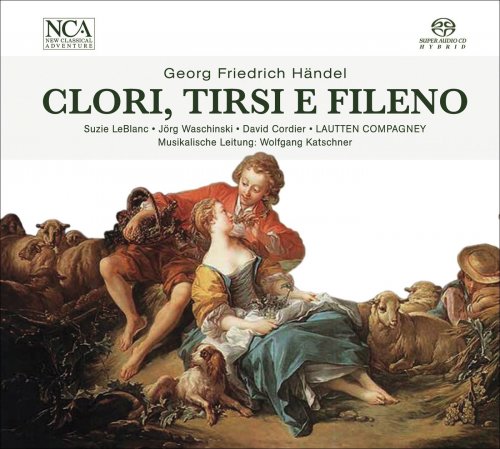Wolfgang Katschner - Handel: Clori, Tirsi e Fileno

Artist: David Cordier, Jörg Waschinski, Wolfgang Katschner, Lautten Compagney & Suzie LeBlanc
Title: Handel: Cor fedele (Clori, Tirsi e Fileno)
Year Of Release: 1997 / 2009
Label: New Classical Adventures
Genre: Classical
Quality: FLAC (image + .cue, log, artwork)
Total Time: 01:15:58
Total Size: 378 MB
WebSite: Album Preview
Tracklist:Title: Handel: Cor fedele (Clori, Tirsi e Fileno)
Year Of Release: 1997 / 2009
Label: New Classical Adventures
Genre: Classical
Quality: FLAC (image + .cue, log, artwork)
Total Time: 01:15:58
Total Size: 378 MB
WebSite: Album Preview
01. Overture
02. Cor Fedele, in Vano Speri
03. Povero Tirsi, Quanto Soffristi
04. Quell'erbetta Che Smalta Le Sponde
05. Se Il Guardo Non Vaneggia, Ecco Clori
06. Va Col Canto Lusingando
07. Dubbia Cosi, O Fileno
08. Sai Perche L'onda Del Fiume
09. Vezzoso Pastorello
10. Conosco Che Mi Piaci
11. Dunque Sperando in Vano
12. Son Come Quel Nocchiero
13. S'altra Pace Non Brami, Altro Conforto
14. Scherzando Sul Tuo Volto
15. Fermati
16. Creder D'un Angure Al Sibilo Fatale
17. Tra Le Fere La Fera Piu Cruda
18. Tirsi, Mio Caro Tirsi, Ah!
19. Barbaro! Tu Non Credi
20. Pur Cederti Mi E Forza Anco a Dispetto
21. Amo Tirsi, Ed a Fileno
22. Va, Fidati a Promessa, a Giuramenti
23. Povera Fedelta
24. Non Ti Stupir, Fileno
25. Un Sospiretto, D'un Labbro Pallido
26. Tirsi, Amico E Compagno
27. Come La Rondinella Dall'Egitto
28. Cosi, Felici E Avventurosi Amanti
29. Vivere E Non Amar, Amare E Non Languir
This is a reissue of a 1997 recording from the Handel festival in Halle. Handel’s Clori, Tirsi e Fileno is a secular cantata composed in 1707 for the Italian nobility. Though a fairly obscure work, many of the arias sound familiar as they were indeed reworked as some of the central arias for the composer’s later operas. This sweet little pastorale tells the story of a shepherdess (Suzie LeBlanc, soprano) who strings along suitors Tirsi (Jörg Waschinski, sopranist) and Fileno (David Cordier, alto) until they tire of her two-timing machinations. The singers are suitably matched and the combination of the three treble voices paints a light and carefree comic impression. While the liner notes include an English translation, unfortunately, the text does not, although from the performance and musical language, it is easy to imagine the events. That the piece is an early piece of Handel’s is demonstrated by the fluid alternation of dialogue between characters, dialogue with the orchestra, arioso and da capo forms. Purity, vocal clarity, the expressiveness of obbligato sections and the precision of the seven-member ensemble are hallmarks of this performance, well worth its revival.
![Eshon Burgundy - Safe Place (Bossa Nova Jazz) (2025) [Hi-Res] Eshon Burgundy - Safe Place (Bossa Nova Jazz) (2025) [Hi-Res]](https://www.dibpic.com/uploads/posts/2025-12/1766079194_cover.jpg)

![Betty Carter - The Music Never Stops (2019) [Hi-Res] Betty Carter - The Music Never Stops (2019) [Hi-Res]](https://www.dibpic.com/uploads/posts/2025-12/1765896843_bcmn500.jpg)

![Ready Player 3 - Ready Player 3 (2025) [Hi-Res] Ready Player 3 - Ready Player 3 (2025) [Hi-Res]](https://www.dibpic.com/uploads/posts/2025-12/1766128773_cover.jpg)



